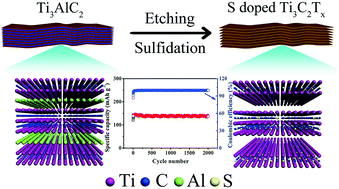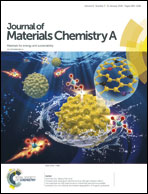Improved sodium-ion storage performance of Ti3C2Tx MXenes by sulfur doping†
Abstract
The sodium storage performance of recently reported Ti3C2Tx MXenes is seriously restricted by their low specific capacity due to their insufficient interlayer spacing. Herein, for the first time, a sulfur (S) doped multilayered Ti3C2Tx MXene was prepared by a simple sulfidation treatment of Ti3C2Tx using thiourea as the S source, which shows an increased interlayer spacing and enhanced electrical conductivity. When used as an anode for sodium-ion batteries (SIBs), the S-doped Ti3C2Tx exhibits a high reversible capacity of 183.2 mA h g−1 after 100 cycles at 0.1 A g−1, excellent rate capability (121.3 mA h g−1 at 2 A g−1 and 113.9 mA h g−1 at 4 A g−1) and robust long-term cycling stability with a reversible capacity of 138.2 mA h g−1 after 2000 cycles at 0.5 A g−1. Notably, the superior sodium storage performance should be attributed to the multilayered morphology, expanded interlayer spacing and enhanced electrical conductivity as well as the high contribution of surface-induced capacitive behavior after S doping, and it outperforms those of reported Ti3C2Tx based electrodes, highlighting the feasibility of the S doping strategy. Most importantly, this work offers a novel approach for smart design and rational fabrication of heteroatom-doped MXenes for energy storage and conversion applications.



 Please wait while we load your content...
Please wait while we load your content...